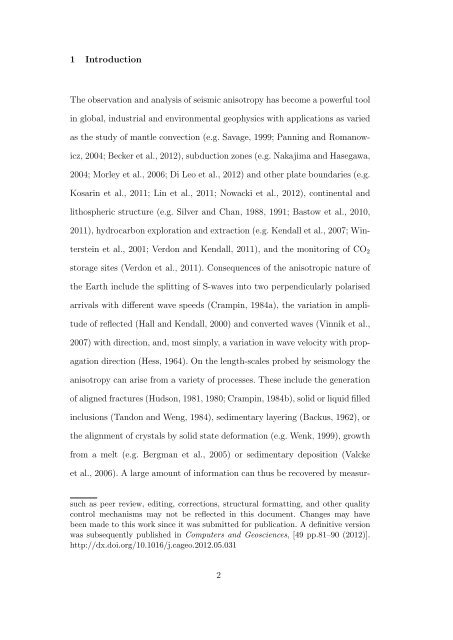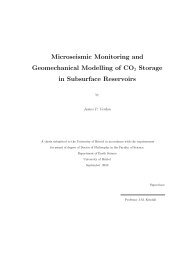MSAT - University of Bristol
MSAT - University of Bristol
MSAT - University of Bristol
You also want an ePaper? Increase the reach of your titles
YUMPU automatically turns print PDFs into web optimized ePapers that Google loves.
1 Introduction<br />
The observation and analysis <strong>of</strong> seismic anisotropy has become a powerful tool<br />
in global, industrial and environmental geophysics with applications as varied<br />
as the study <strong>of</strong> mantle convection (e.g. Savage, 1999; Panning and Romanowicz,<br />
2004; Becker et al., 2012), subduction zones (e.g. Nakajima and Hasegawa,<br />
2004; Morley et al., 2006; Di Leo et al., 2012) and other plate boundaries (e.g.<br />
Kosarin et al., 2011; Lin et al., 2011; Nowacki et al., 2012), continental and<br />
lithospheric structure (e.g. Silver and Chan, 1988, 1991; Bastow et al., 2010,<br />
2011), hydrocarbon exploration and extraction (e.g. Kendall et al., 2007; Winterstein<br />
et al., 2001; Verdon and Kendall, 2011), and the monitoring <strong>of</strong> CO 2<br />
storage sites (Verdon et al., 2011). Consequences <strong>of</strong> the anisotropic nature <strong>of</strong><br />
the Earth include the splitting <strong>of</strong> S-waves into two perpendicularly polarised<br />
arrivals with different wave speeds (Crampin, 1984a), the variation in amplitude<br />
<strong>of</strong> reflected (Hall and Kendall, 2000) and converted waves (Vinnik et al.,<br />
2007) with direction, and, most simply, a variation in wave velocity with propagation<br />
direction (Hess, 1964). On the length-scales probed by seismology the<br />
anisotropy can arise from a variety <strong>of</strong> processes. These include the generation<br />
<strong>of</strong> aligned fractures (Hudson, 1981, 1980; Crampin, 1984b), solid or liquid filled<br />
inclusions (Tandon and Weng, 1984), sedimentary layering (Backus, 1962), or<br />
the alignment <strong>of</strong> crystals by solid state deformation (e.g. Wenk, 1999), growth<br />
from a melt (e.g. Bergman et al., 2005) or sedimentary deposition (Valcke<br />
et al., 2006). A large amount <strong>of</strong> information can thus be recovered by measursuch<br />
as peer review, editing, corrections, structural formatting, and other quality<br />
control mechanisms may not be reflected in this document. Changes may have<br />
been made to this work since it was submitted for publication. A definitive version<br />
was subsequently published in Computers and Geosciences, [49 pp.81–90 (2012)].<br />
http://dx.doi.org/10.1016/j.cageo.2012.05.031<br />
2











